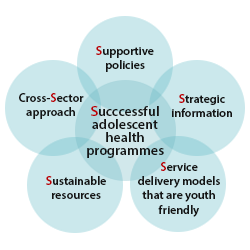Adolescent health

WHO supports Member States in improving adolescent health in three main ways: by recommending comprehensive, multi-sectoral and evidence-informed adolescent health approaches; by delineating and supporting the critical contribution of the health sector, including the leadership role of health ministries to influence other sectors, such as education, employment and social protection policies; and by fostering actions towards reducing inequalities in health and development of adolescents within and between countries. It contributes to the formulation and implementation of the new European health policy Health 2020 (resolution EUR/RC60/R5), by bringing together and interconnecting coherently new knowledge and evidence on health of adolescents and its determinants, and proposing governance solutions and effective interventions for better health, equity and well-being.
Young and healthy?
Adolescence, the period between 10 and 19 years, is a period of major physical and psychological change, as well as great changes in social interactions and relationships. Although most adolescents make the transition into adulthood in good health, some do not. Some young people are cut down by suicide, violence, traffic accidents or the consequences of unsafe abortion. Others have to cope with infectious or chronic disease. Some health problems affect them later in life, for example, obesity from poor eating and exercise habits, HIV-related illnesses, or lung cancer resulting from tobacco use.
In the WHO European Region, more than 300 young people die every day from largely preventable causes. Almost 1 in 10 18-year-olds in the Region suffers from depression. Concern is growing about the increased use of alcohol and binge-drinking, and the high rates of homicides, traffic injuries and suicides, particularly among young men in eastern Europe. Increasing burden of chronic conditions among adolescents will put a growing pressure on health systems in the coming decades.
WHO approach to adolescent health programmes
Investing in the health of adolescents helps to prevent the vicious cycle of ill-health and socioeconomic deprivation. It helps to produce health, but also to generate wealth because young people are central to the present and future wealth and well-being of our societies.
A systematic approach - the 5 S approach - has been developed by WHO to support countries in strengthening their response to adolescent health. The approach recognizes the need, and offers tools, for
- Supportive policies that respect, protect and fulfil the rights of adolescents to health;
- Strategic information to monitor the health situation and assess health trends, as well as to plan, monitor and evaluate policies and interventions;
- Service delivery models that are youth-friendly, including school health services and primary care;
- Sustainable resources that pay attention to adequately trained healthcare personnel and financial protection of young people against expenditure that prohibit access to services ;
- cross-Sectors approach which recognizes that while health sector has its specific contribution to young people health, other sectors such as education, labour, social protection need to adopt policies to tackle socio-economic determinants, and reduce inequalities.



